Managing for lift truck operator safety
Sure, lift truck operators are on the front lines of safe operation, but having a strong safety program takes plenty of management involvement as well.
Lift truck safety relies heavily on each individual operator to follow through on best practices and thoroughly perform safety check lists, but when it comes to having a strong lift truck safety program, the operators can’t do it on their own.
The best programs have strong management support and hands-on involvement, from everything to setting policies to proactively seeing firsthand what operators are dealing with.
Tom Lego, Toyota brand ambassador at Toyota Material Handling, sees three areas of management contribution to a strong lift truck safety program: hands-on involvement; instilling a strong safety culture; and making sure the layout, equipment and working environment at each site supports safety.
The first aspect of hands-on involvement should go beyond setting policies or reviewing safety data in an office, to getting out on the floor to observe workflow or traffic challenges operators may be facing, says Lego. “We really need to have the management team for wherever that lift truck equipment is going to be used to be proactive and not just reactive,” says Lego. “At Toyota facilities, part of being proactive is a practice we call genchi genbutsu, which means ‘go and see.’ We like our managers to go out on the floor and see the units in operation. Even if every manager involved can’t physically go out to each facility on a regular basis, somebody can show them a map of the layout and routes, or some video of traffic in a facility, so they can see those paths and what the issues may be.”
Second, says Lego, managers are ultimately responsible for instilling a strong safety culture. That starts with respect for the operators as professionals and focuses on setting clear expectations on policies, like investigating all near-miss incidents or documenting any incidents where equipment got scratched.
“If you reset the expectation that we’re not going to bump into things—that we are going to clean our truck units up, and anytime there even a little nick or scratch, we’re going to be reporting that out and discussing how it happened—that can be pretty life changing for operators because for that first few weeks they’re going to be writing more reports” says Lego. “But what happens once that expectation has been reset, is that fairly soon you won’t have those incidents, because people are getting off their forklifts to move things rather than nudge them, and they are talking to people about how make the aisles appropriate for operation of the trucks.”
Similarly, says Lego, management can insist on pedestrian safety training, so any new worker or site visitor is instructed on which paths in aisles are safe for walking and which areas to keep out of. Toyota’s facilities have designated stop points for pedestrians, and pedestrians even use hand signals as visual cues for equipment operators or others nearby.
“If you reset the expectation that we’re not going to bump into things—that we are going to clean our truck units up, and anytime there even a little nick or scratch, we’re going to be reporting that out and discussing how it happened—that can be pretty life changing for operators…” - Tom Lego, Toyota brand ambassador at Toyota Material Handling
A third way managers can support safety is by making sure the site and its workflows are conducive to safe operation, says Lego. This can involve many details, such as ensuring each workflow has appropriate lift trucks and accessories, or it may involve setting up pedestrian aisles, safety signage or floor markings, redesigning layouts to improve traffic flow, or taking care of issues like poor lighting or surfaces that may need additional traction.
When all these factors come together, there can be a more standardized approach to safety by everyone at the site. “I think part of that management responsibility also is standardizing the patterns of work that those folks are doing,” Lego says. “Because the more you can follow a standardized process, the more you can program-in best practices and program out the variabilities that could cause issues.”
Safety experts agree lift truck safety programs should be systematic. As part of the presentations streamed live during the Industrial Truck Association’s National Forklift Safety Day event on June 14 in Washington, D.C., Michael Wood, senior vice president for quality, health, safety and environment for TEAM Industrial Services, observed that having a strong lift truck safety program takes consistent management participation to the point of making the safety program an integrated element of operational excellence.
“Is [safety] an integrated part of operational excellence, so that safety, quality, operations, finance, are managed as part of one system?” Wood asked.
The strongest safety programs, Wood observed, are backed by managers who set clear expectations and consistently enforce rules. Safety programs also need adequate budget and standardized processes with simple and clear policies and procedures, Wood added, as well as a feedback loop for operators that frees them from the chance of repercussions from direct supervisors.
Local and business leadership should also walk the warehouse or shop floor and talk to operators about how things can improve, Wood advised in his talk. “Are we out in the shop engaging with our workforces … to find out what are the issues they’re having and how are we going to help them overcome them? I appreciate those who go from work area to work area so operators can showcase the improvements they made, and so that you can hear what they are passionate about. That starts to get them really engaged.”













